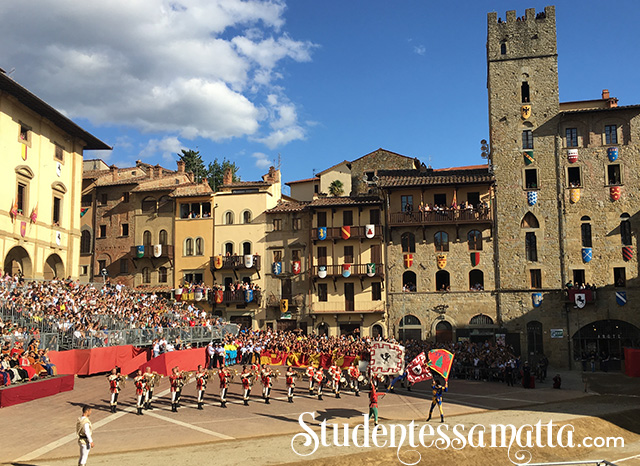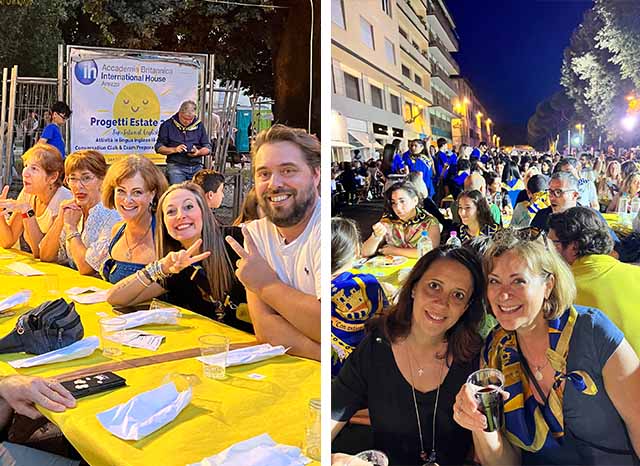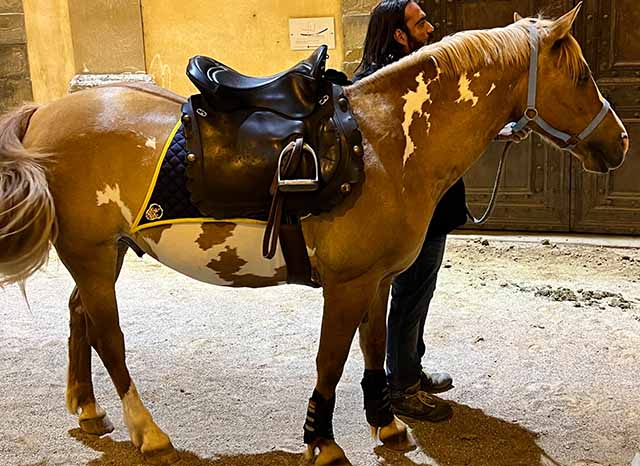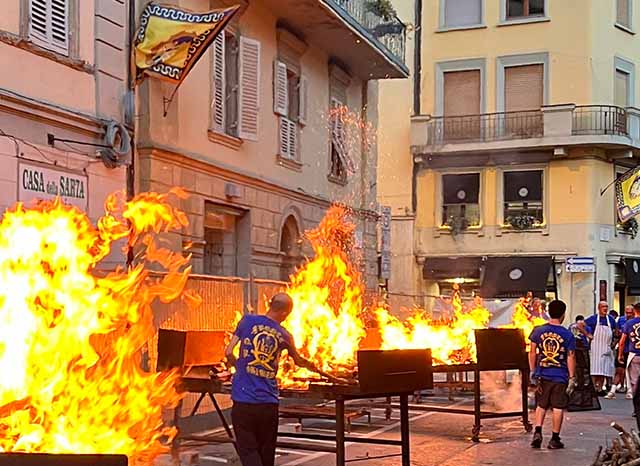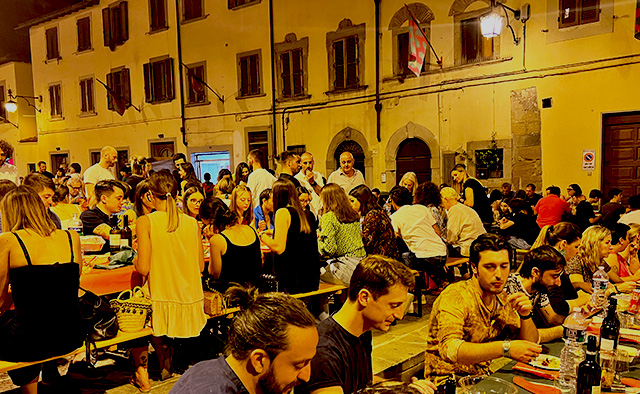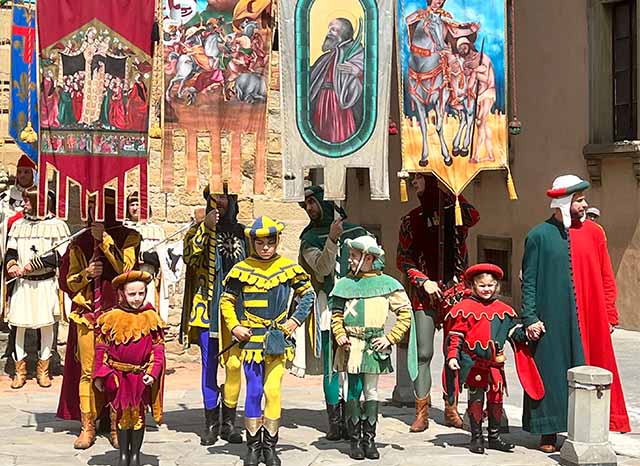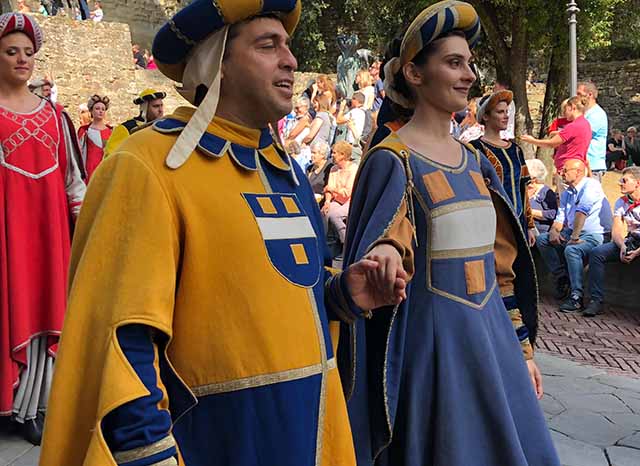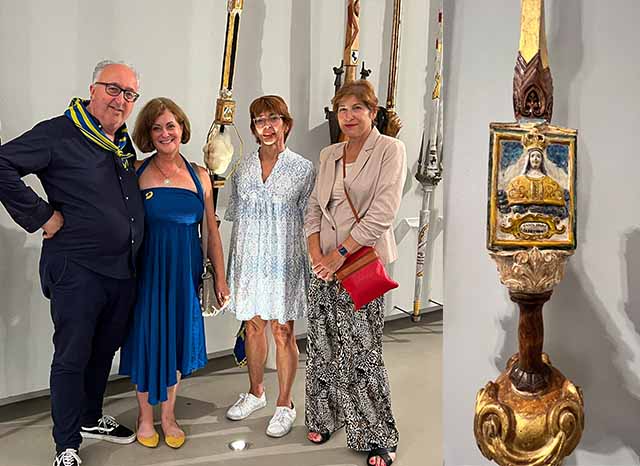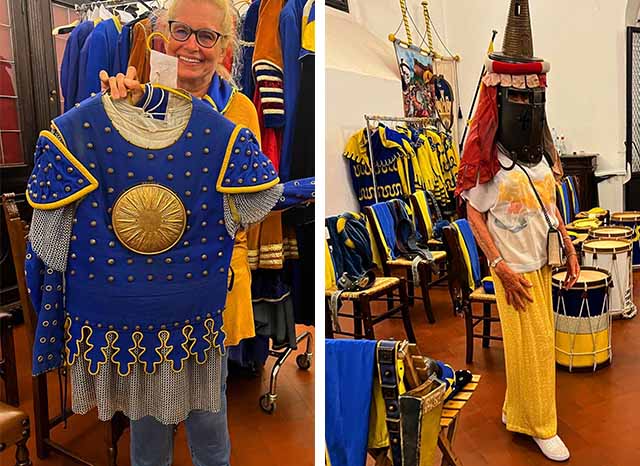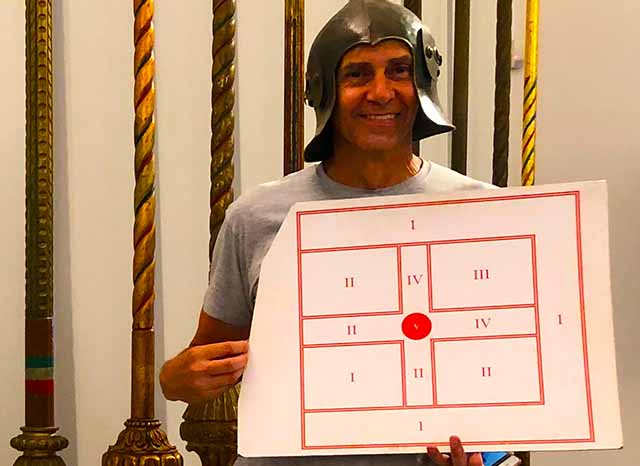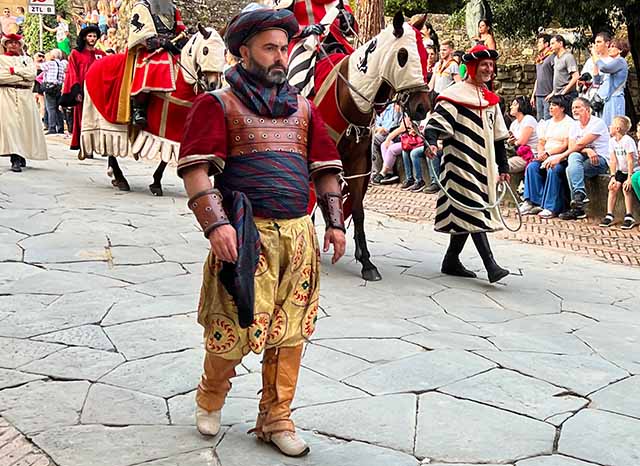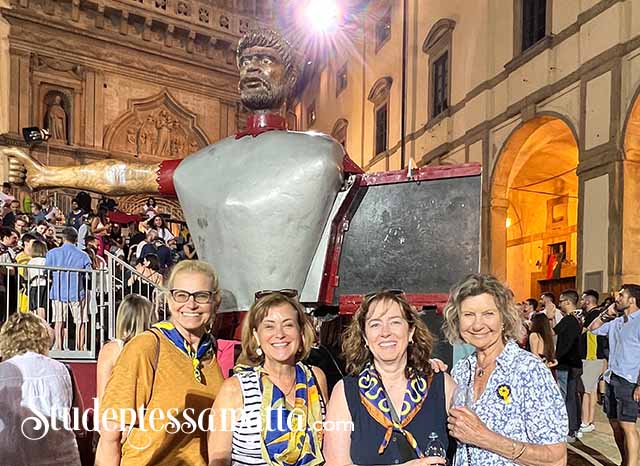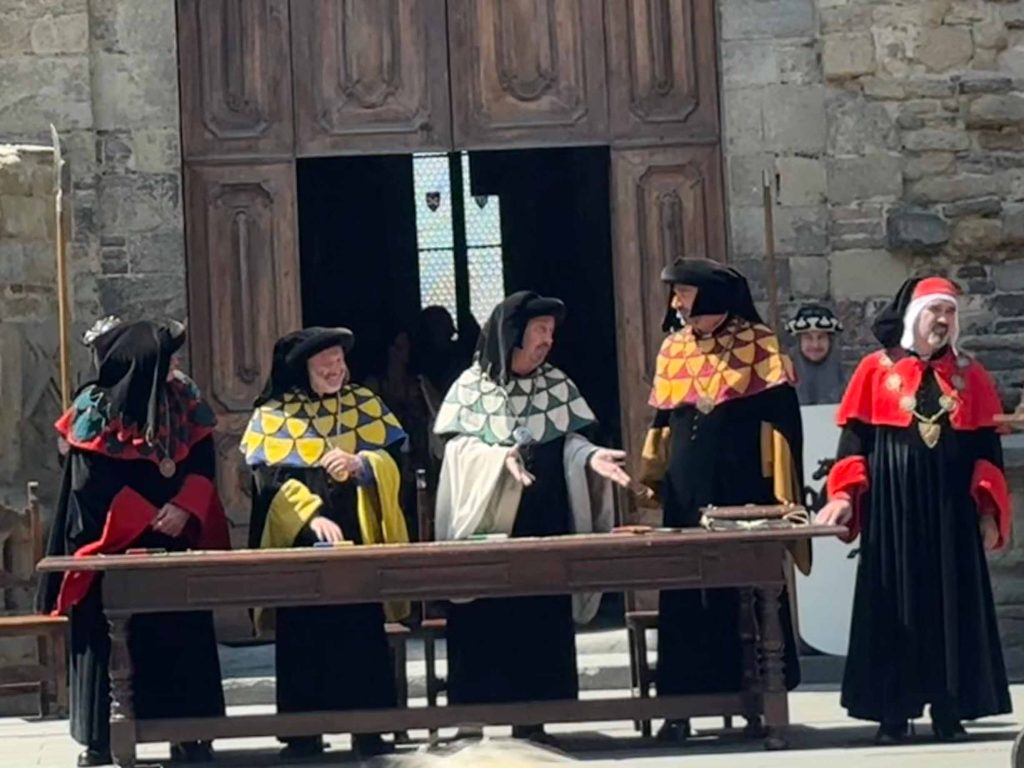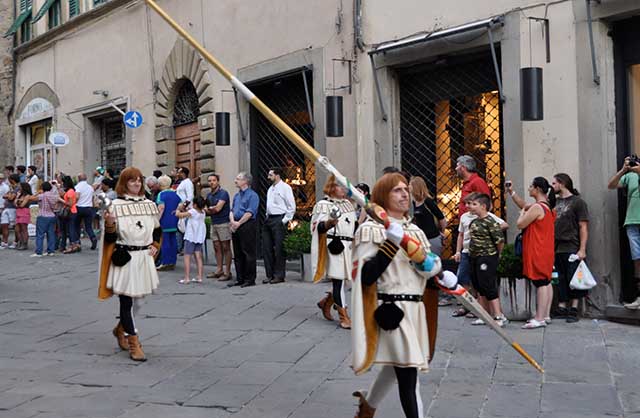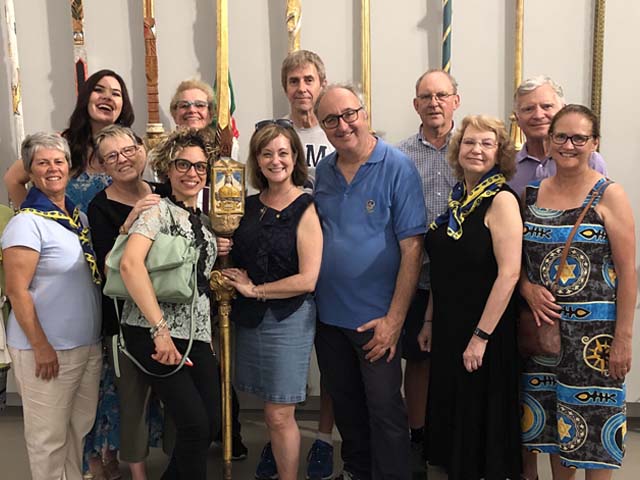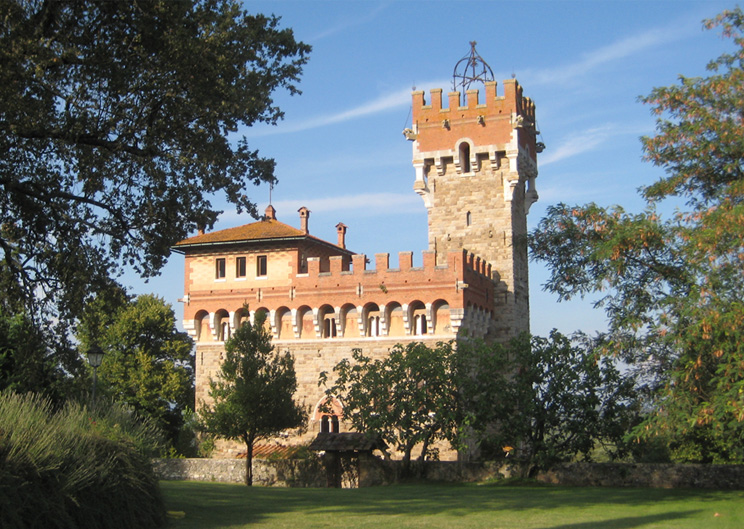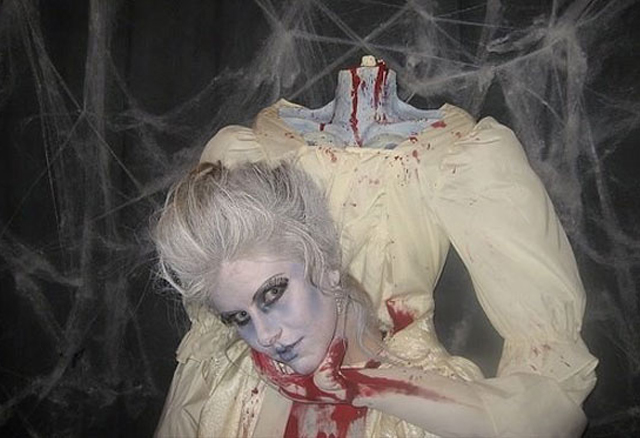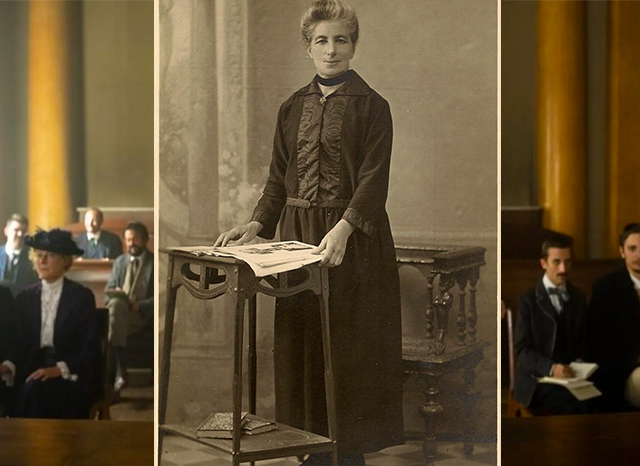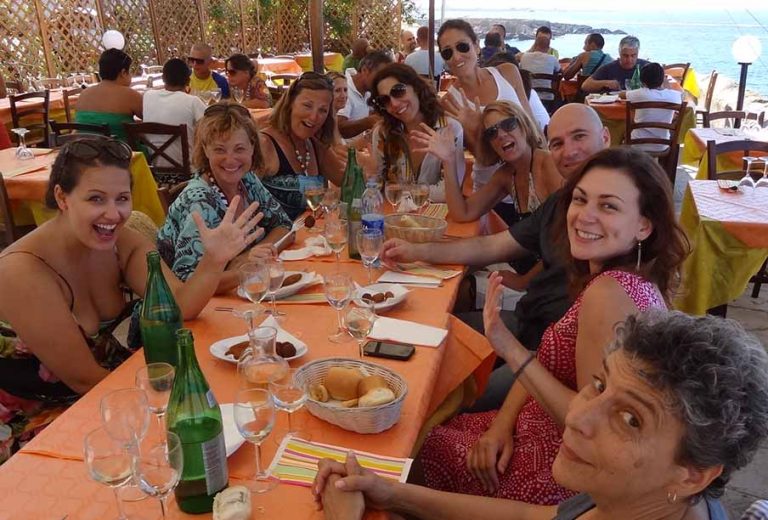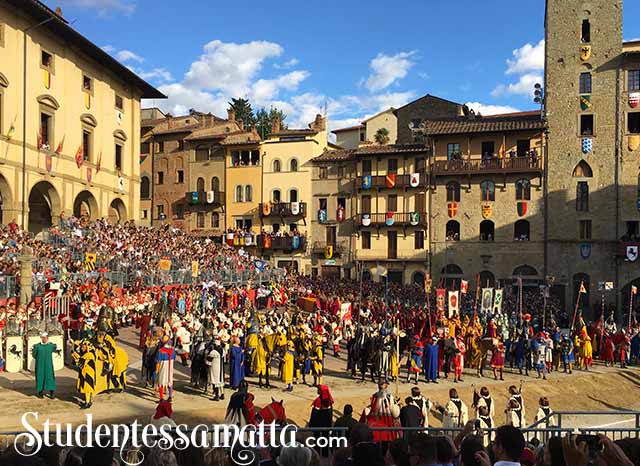
La Storia e il Gioco della Giostra del Saracino
The History and Gameplay of La Giostra del Saracino: Arezzo’s Iconic Medieval Joust
La nascita della Giostra – Origini medievali
The Origins of the Joust – Medieval Beginnings
La Giostra del Saracino di Arezzo è un antico gioco cavalleresco che risale all’epoca medievale. Fu concepita come esercizio militare per preparare un attacco dell’esercito musulmano, che i cristiani temevano stesse risalendo la penisola italiana.
The Saracen Joust of Arezzo, or La Giostra del Saracino, is an ancient game of chivalry that dates back to the Middle Ages. It was devised as a military exercise to prepare for an attack by the Muslim army that Christians feared was advancing up the Italian peninsula.
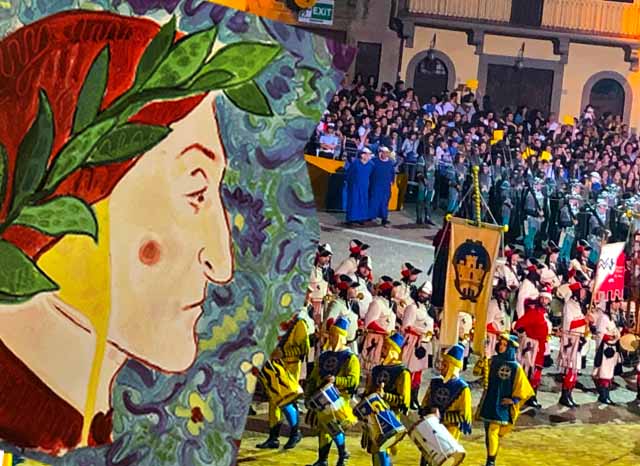
Una tradizione evoluta – Dai Saraceni ai tornei di abilità
An Evolving Tradition – From Saracens to Skill Tournaments
Non ci sono prove che i Saraceni siano mai arrivati fino ad Arezzo. Tuttavia, le manovre della giostra si sono trasformate in tornei di abilità regolarmente organizzati tra il XV e il XVII secolo. Dante Alighieri menziona la giostra all’inizio del canto XXII del suo Inferno.
There is no evidence that the Saracens ever reached Arezzo. However, the maneuvers of the joust evolved into skill tournaments regularly held between the 15th and 17th centuries. Dante Alighieri mentions the joust at the beginning of Canto XXII of his Inferno.
“Io vidi già cavalier muover campo,
e cominciar stormo a far lor mostra,
e tal volta partir per loro scampo;
corridor vidi per la terra vostra,
o Aretini, e vidi gir gualdane,
fedir torneamenti e correr giostra;
quando con trombe, e quando con campane,
con tamburi e con cenni di castella,
e con cose nostrali e con istrane;”
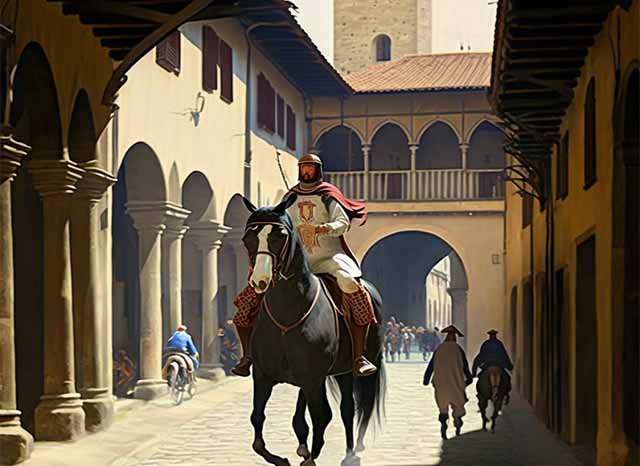
Durante il Medioevo
During the Middle Ages,
Durante il Medioevo, la Giostra di Arezzo si teneva per celebrare importanti dignitari, sovrani, principi e persino Cosimo de’ Medici, duca di Toscana, quando passavano per la città. Tuttavia, con il passare del tempo e l’invasione napoleonica della penisola italiana, compresa la città di Arezzo, nel XVIII secolo, la giostra entrò in un periodo di declino e alla fine si estinse del tutto.
During the Middle Ages, the Giostra di Arezzo was held to celebrate important dignitaries, sovereigns, princes, and even Cosimo de’ Medici, Duke of Tuscany, when they passed through the city. However, over time and with Napoleon’s invasion of the Italian peninsula, including the city of Arezzo, in the 18th century, the joust entered a period of decline and eventually became extinct.
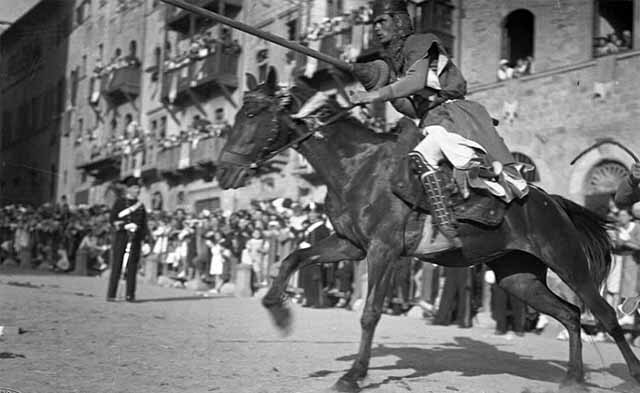
Nel Novecento
In the 20th century,
Nel Novecento, però, la Giostra di Arezzo riacquistò popolarità grazie all’avvento del Romanticismo e al rinnovato apprezzamento del Medievalismo, che portò all’adattamento di modelli medievali alle esigenze contemporanee. Ricevette anche il sostegno del governo fascista di Mussolini, che esaltava le virtù del nazionalismo italiano e l’importanza di promuovere una solida identità culturale.
In the 20th century, however, the Giostra di Arezzo regained popularity thanks to the advent of Romanticism and the renewed appreciation of Medievalism, which led to the adaptation of medieval models to contemporary needs. It also received support from Mussolini’s fascist government, which extolled the virtues of Italian nationalism and the importance of promoting a strong cultural identity.
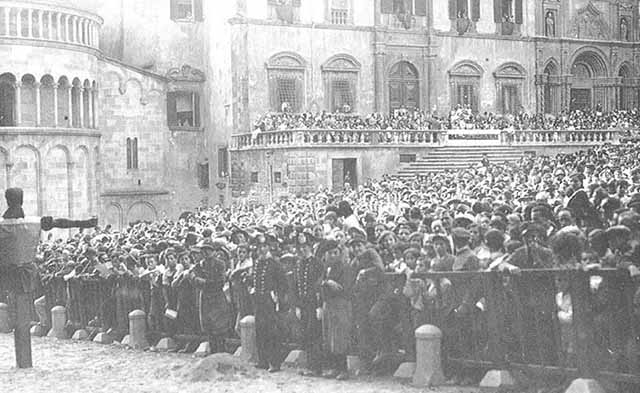
Gli anni di guerra
The war years
Nel 1931, la Giostra di Arezzo rifiorì, trasformandosi nella rievocazione storica competitiva che oggi conosciamo. Tuttavia, durante quel periodo, i fascisti sfruttarono la giostra come strumento di propaganda per promuovere la città a livello nazionale. Nel 1938, i partecipanti alla Giostra di Arezzo furono invitati ai Giardini di Boboli a Firenze per sfilare davanti a Mussolini e Hitler. Nello stesso anno, il Principe Umberto di Savoia e Maria José assistette alla giostra di Arezzo, e nel 1939 fu organizzata un’edizione notturna in onore del Segretario Nazionale del Partito Fascista.
In 1931, the Giostra di Arezzo was revived, transforming into the competitive historical re-enactment we know today. However, during that period, the fascists used the joust as a propaganda tool to promote the city nationally. In 1938, participants in the Giostra di Arezzo were invited to the Boboli Gardens in Florence to parade before Mussolini and Hitler. That same year, Prince Umberto of Savoy and Maria José attended the joust in Arezzo, and in 1939 a night edition was organized in honor of the National Secretary of the Fascist Party.
L’ultima Giostra prima della Seconda Guerra Mondiale si tenne il 9 giugno 1940, lo stesso giorno in cui Mussolini dichiarò guerra. Porta Santo Spirito vinse il torneo quel giorno, ma con lo scoppio della guerra passarono otto lunghi anni prima che il Buratto e le giostre tornassero in Piazza Grande. Il loro ritorno avvenne con una certa riluttanza, poiché molti ad Arezzo avevano iniziato ad associare la Giostra a Mussolini e alle idee fasciste che volevano lasciarsi alle spalle.
The last Giostra before World War II took place on June 9, 1940, the same day Mussolini declared war. Porta Santo Spirito won the tournament that day, but with the outbreak of the war, it took eight long years before the Buratto and the jousts returned to Piazza Grande. Their return happened with some reluctance, as many in Arezzo had begun to associate the Giostra with Mussolini and the fascist ideas they wanted to leave behind.
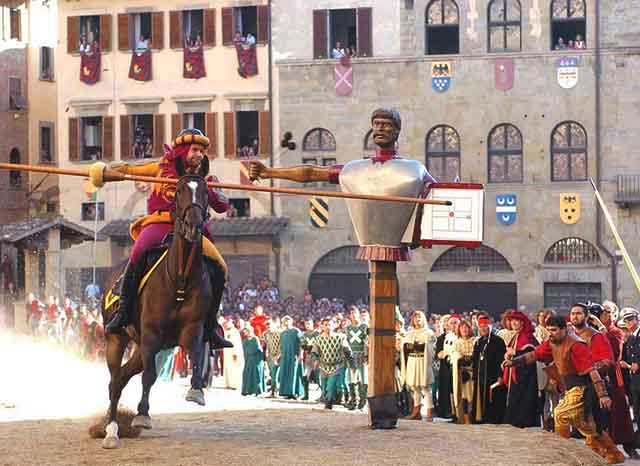
Dopo la guerra – Un ritorno riflessivo
Post-War Period – A Thoughtful Return
Dopo molti dibattiti e riflessioni, tuttavia, gli Aretini si resero conto che la Giostra era una tradizione unica, di cui essere orgogliosi. Compresero che questo torneo cavalleresco non era un’invenzione esagerata dai burocrati pomposi, ma una tradizione ancora viva nella cultura popolare. Così, nel 1948, abbracciarono nuovamente la Giostra del Saracino, riprendendo i tornei in Piazza Grande due volte l’anno da quella data in poi. Nel mese di giugno, la Giostra viene celebrata durante una serata dedicata a San Donato, patrono della città. A settembre, invece, la Giostra si tiene la prima domenica pomeriggio del mese ed è dedicata alla Madonna del Conforto.
After much debate and reflection, however, the Aretini realized that the Giostra was a unique tradition to be proud of. They understood that this chivalric tournament was not an exaggerated invention by pompous bureaucrats, but a tradition still alive in popular culture. Thus, in 1948, they embraced the Giostra del Saracino once again, resuming the tournaments in Piazza Grande twice a year from that date on. In June, the Giostra is celebrated during an evening dedicated to San Donato, the patron saint of the city. In September, instead, the Giostra is held on the first Sunday afternoon of the month and is dedicated to the Madonna del Conforto.
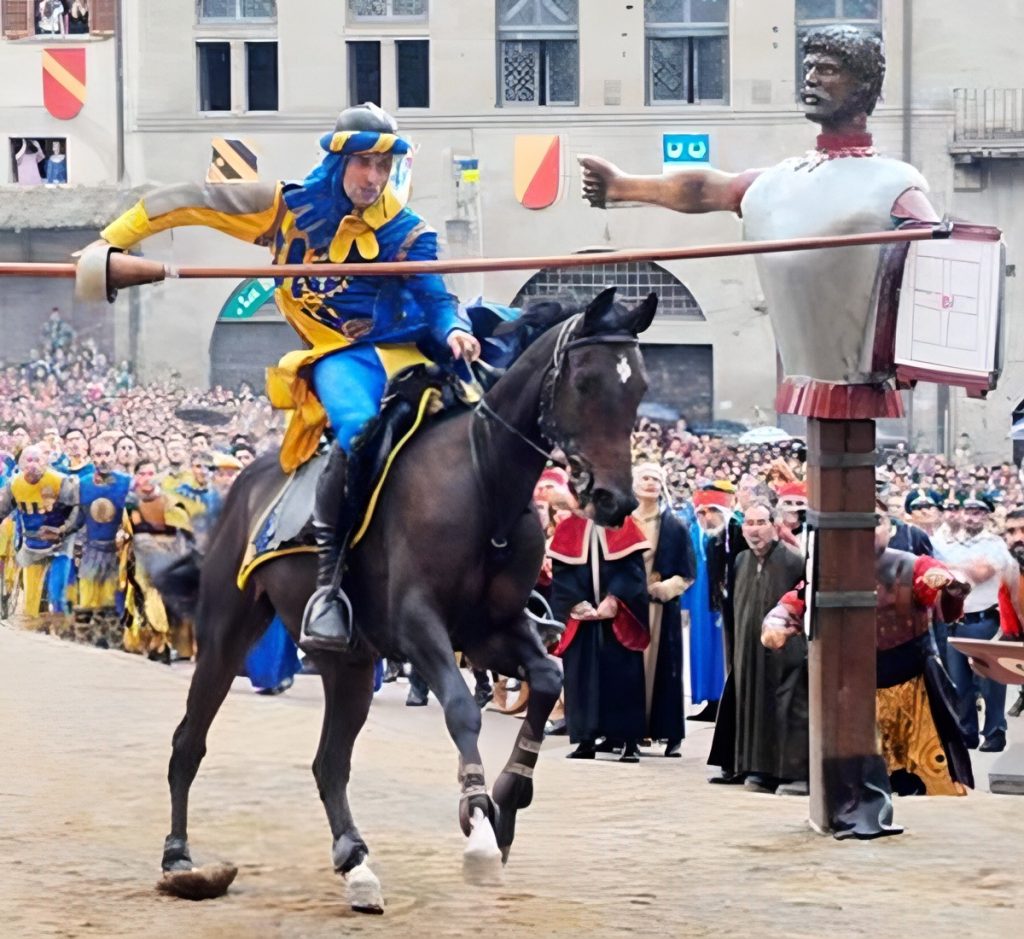
Una celebrazione moderna – Spirito di competizione e festa
A Modern Celebration – Spirit of Competition and Festivity
Oggi la Giostra del Saracino rimane un evento illustre e una feroce competizione tra i quattro quartieri che ancora definiscono la città di Arezzo. Due volte l’anno, striscioni colorati sventolano e i cittadini indossano con orgoglio i colori del loro quartiere, tifando per le loro squadre a banchetti, balli ed eventi pubblici. Gli Aretini sono competitivi e a volte aggressivi in piazza, ma sono anche amanti del divertimento e sembrano dannatamente bene in costumi medievali. Unendo tutto questo alla storia e alla lunga tradizione cavalleresca, si comprende cosa rende la Giostra del Saracino di Arezzo così affascinante e coinvolgente.
Today, the Giostra del Saracino remains an illustrious event and a fierce competition between the four neighborhoods that still define the city of Arezzo. Twice a year, colorful banners fly, and citizens proudly wear their neighborhood colors, cheering for their teams at banquets, dances, and public events. The Aretini are competitive and sometimes aggressive in the piazza, but they are also fun-loving and look damn good in medieval costumes. Combining all this with history and a long chivalric tradition, one understands what makes the Giostra del Saracino in Arezzo so fascinating and engaging.
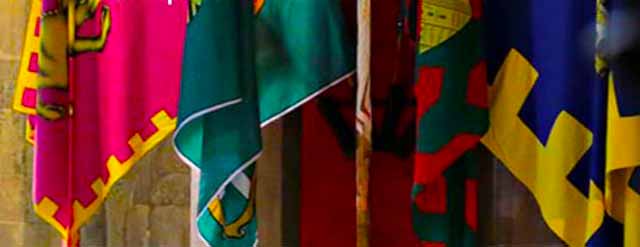
I quattro quartieri di Arezzo, i loro appassionati tifosi e i valorosi giostratori
The Four Neighborhoods of Arezzo, their Fans, and Jousters
La gente di Arezzo è profondamente appassionata alla Giostra e prende molto sul serio le rivalità tra quartieri. Ogni quartiere è supportato dai suoi tifosi, che si occupano di tutto: dai costumi alla Cena Propiziatoria (la cena celebrativa per augurare buona fortuna alla Giostra la sera prima dell’evento), dalla raccolta fondi all’accensione delle griglie, dalla supervisione del museo della giostra del quartiere alla manutenzione dei cavalli.
The people of Arezzo are deeply passionate about the Giostra and take neighborhood rivalries very seriously. Each neighborhood is supported by its fans, who take care of everything: from costumes to the Propitiatory Dinner (the celebratory dinner to wish good luck for the Giostra the night before the event), from fundraising to lighting the grills, from supervising the neighborhood’s joust museum to maintaining the horses.
Arezzo è suddivisa in quattro quartieri, che rappresentano le quattro porte medievali originali della città. Nel corso degli anni, i quartieri si sono trasformati e consolidati in queste quattro “squadre designate.”
Arezzo is divided into four neighborhoods, representing the four original medieval gates of the city. Over the years, the neighborhoods have transformed and consolidated into these four “designated teams.”

San Andrea (green and white)
Porta Sant’Andrea is located near Porta Trento Trieste, in the Via delle Gagliarde neighborhood. Its patron saint is Sant’Andrea, and the church is dedicated to Sant’Agostino.

Porta Crucifera (red e green)
Porta Crucifera is the neighborhood of the city where Piazza Grande is located. Its territory extends in the northeastern sector of Arezzo. The patron saint is San Martino, and its church is Santa Croce. This neighborhood is also known as the District of Colcitrone.

Porta del Foro, also known as Porta San Lorentino (yellow and maroon)
Porta del Foro, where the Chimera was discovered and is featured in its emblem, lies in the northwestern part of the city. The district includes the ancient Cortine, the Visconteria of Montagna, and the Visconteria of Valdambra Oltre Arno. Its patron saints are San Lorentino and Pergentino, and the church is the Basilica of San Domenico.

Porta Santo Spirito (yellow and blu)
Porta Santo Spirito is located at the beginning of Corso Italia and San Jacopo, where the two bastions are found, the remaining parts of the Arezzo walls that were bombed during the war. The district’s territory extends in the southwestern sector of the city. The patron saint is San Giacomo, and its church is Sant’Antonio Abate in Saione.

I giostratori / The Jousters
Ogni quartiere ha due giostratori principali che si alternano in gara in Piazza Grande per il premio della Lancia d’Oro durante i tornei. Ogni quartiere dispone anche di una scuderia nella campagna intorno ad Arezzo, dove i giostratori si allenano tutto l’anno. La pista è ricreata per simulare le condizioni di Piazza Grande, con il campo, le tribune e persino il rumore della folla. I giostratori si allenano incessantemente, con una breve pausa durante l’inverno. Questa abilità unica consiste nel tenere una lancia di legno di sette libbre in una mano mentre si dirige il cavallo con l’altra su una pista inclinata, per colpire un bersaglio delle dimensioni di una moneta d’argento!
Each neighborhood has two main jousters who take turns competing in Piazza Grande for the Golden Lance prize during the tournaments. Each neighborhood also has a stable in the countryside around Arezzo, where the jousters train all year round. The track is recreated to simulate the conditions of Piazza Grande, with the field, stands, and even the crowd noise. The jousters train tirelessly, with a short break during the winter. This unique skill involves holding a seven-pound wooden lance in one hand while directing the horse with the other on an inclined track to hit a target the size of a silver dollar!
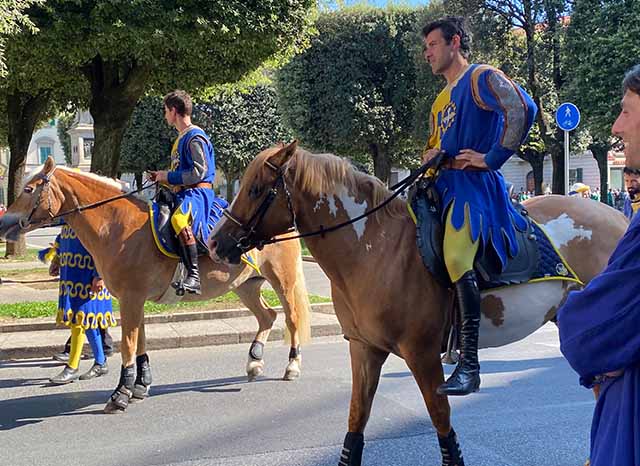
Accanto a questi professionisti agili e stagionati si allenano uomini più giovani che si preparano a prendere le redini un giorno. Ogni anno, i giovani hanno la possibilità di essere protagonisti durante la Provaccia – la giostra di prove che si tiene il giovedì sera prima dell’evento principale del fine settimana. I vincitori della Provaccia ricevono come premio una porchetta, o maiale alla griglia. La leggenda vuole che il quartiere che vince la Provaccia non vincerà la successiva Giostra.
Alongside these agile and seasoned professionals, younger men train, preparing to take the reins one day. Each year, the young have the opportunity to shine during the Provaccia – the practice joust held on Thursday evening before the main weekend event. The winners of the Provaccia receive a porchetta, or roasted pig, as a prize. Legend has it that the neighborhood that wins the Provaccia will not win the following Giostra.
La Giostra del Saracino si svolge due volte l’anno, a giugno e settembre, in Piazza Grande ad Arezzo. Per un breve periodo, la Giostra si tenne a Prato, vicino al Duomo, ma in epoca contemporanea l’evento è stato spostato in Piazza Grande. Da vecchie foto si nota che il posizionamento della pista in Piazza Grande è stato modificato nel tempo.
The Giostra del Saracino takes place twice a year, in June and September, in Piazza Grande in Arezzo. For a brief period, the Giostra was held in Prato, near the Duomo, but in contemporary times the event was moved to Piazza Grande. Old photos show that the positioning of the track in Piazza Grande has changed over time.
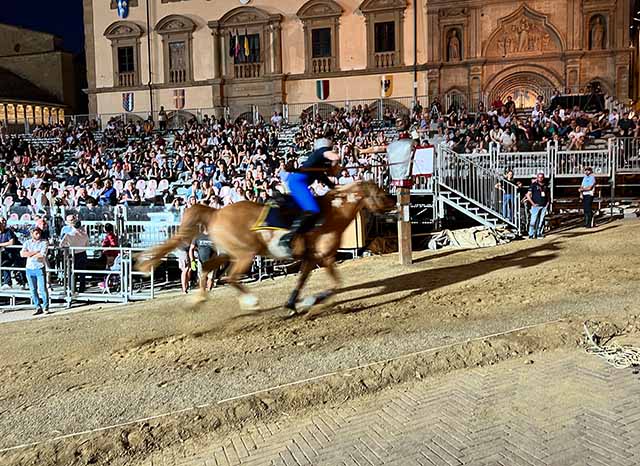
La “Lizza” / The Race Track
Ogni quartiere ha due giostratori principali che si alternano in gara in Piazza Grande per il premio della Lancia d’Oro durante i tornei. Ogni quartiere dispone anche di una scuderia nella campagna intorno ad Arezzo, dove i giostratori si allenano tutto l’anno. La pista è ricreata per simulare le condizioni di Piazza Grande, con il campo, le tribune e persino il rumore della folla. I giostratori si allenano incessantemente, con una breve pausa durante l’inverno. Questa abilità unica consiste nel tenere una lancia di legno di sette libbre in una mano mentre si dirige il cavallo con l’altra su una pista inclinata, per colpire un bersaglio delle dimensioni di una moneta d’argento!
Each neighborhood has two main jousters who take turns competing in Piazza Grande for the Golden Lance prize during the tournaments. Each neighborhood also has a stable in the countryside around Arezzo, where the jousters train all year round. The track is recreated to simulate the conditions of Piazza Grande, with the field, stands, and even the crowd noise. The jousters train tirelessly, with a short break during the winter. This unique skill involves holding a seven-pound wooden lance in one hand while directing the horse with the other on an inclined track to hit a target the size of a silver dollar!
Una settimana prima della giostra, tumuli di terra e sabbia vengono portati in Piazza Grande per costruire la “Lizza”, la pista rialzata e liscia che i giostratori usano per attraversare la piazza a cavallo. Intorno alla piazza vengono costruite delle tribune per gli spettatori.
A week before the joust, mounds of earth and sand are brought to Piazza Grande to build the “Lizza,” the smooth raised track that the jousters use to cross the piazza on horseback. Stands are constructed around the piazza for the spectators.
Le sfilate, le bandiere e i costumi
The parades, the flags, and the costumes
La Giostra del Saracino è una celebrazione dell’orgoglio civico. Ogni quartiere mostra con fierezza i propri colori, con bandiere appese agli edifici e foulard indossati al collo dei tifosi. Durante la settimana precedente la Giostra, feste, cene e celebrazioni animano la città in attesa dell’evento principale in Piazza Grande. Per le strade di Arezzo, batteristi e musicisti praticano un ritmo ipnotizzante, e il giorno della Giostra, 350 partecipanti in autentici costumi medievali sfilano per la città, esibendo il loro orgoglio civico e di quartiere.
The Giostra del Saracino is a celebration of civic pride. Each neighborhood proudly displays its colors, with flags hanging from buildings and scarves worn by fans. During the week leading up to the Giostra, parties, dinners, and celebrations animate the city in anticipation of the main event in Piazza Grande. In the streets of Arezzo, drummers and musicians practice a hypnotic rhythm, and on the day of the Giostra, 350 participants in authentic medieval costumes parade through the city, showcasing their civic and neighborhood pride.
Nel 1932, Luigi Sapelli, costumista della Scala di Milano, progettò i costumi per la Giostra del Saracino. Prima di allora, i costumi erano stati noleggiati. Successivamente, nel 1954, furono rifatti da Nino Vittorio Novarese, regista e designer di Cinecittà. Si dice che i disegni siano ispirati agli affreschi di Piero della Francesca che decorano la chiesa di San Francesco ad Arezzo.
In 1932, Luigi Sapelli, a costume designer from La Scala in Milan, designed the costumes for the Giostra del Saracino. Before that, the costumes were rented. Later, in 1954, they were redesigned by Nino Vittorio Novarese, a director and designer from Cinecittà. It is said that the designs are inspired by the frescoes of Piero della Francesca that decorate the church of San Francesco in Arezzo.
Il Buratto rappresenta il Re Saraceno delle Indie
The Buratto represents the Saracen King of the Indies
Il Buratto è un’effigie di legno a grandezza naturale che rappresenta il Re Saraceno delle Indie. È il “bersaglio” che i giostratori devono colpire per guadagnare punti e vincere la giostra per la loro squadra.
The Buratto is a life-sized wooden effigy representing the Saracen King of the Indies. It is the “target” that the jousters must hit to score points and win the joust for their team.
Il manichino ha un grande segnapunti diviso in zone, con punti che vanno da 1 a 5, su una mano. Nell’altra mano tiene un gatto a nove code. Quando viene colpito, il Buratto gira su una picca. Se un giostratore galoppa troppo lentamente, verrà colpito alla schiena dalla frusta; se galoppa troppo velocemente, rischia di mancare l’occhio del toro. Le tre palline di pelle (250 grammi ciascuna) sono appese a lunghe corde di cuoio. Prima di ogni corsa, le palline vengono spruzzate dal guardiano con polvere nera in modo che un’impronta sia lasciata sulle spalle del giostratore se il Buratto riesce a colpirlo. Il Buratto è seguito e servito durante la Giostra da due inservienti saraceni che indossano abiti musulmani.
The mannequin has a large scoreboard divided into zones, with points ranging from 1 to 5 on one hand. In the other hand, it holds a cat-o’-nine-tails. When hit, the Buratto spins on a pole. If a jouster gallops too slowly, he will be hit on the back by the whip; if he gallops too fast, he risks missing the bull’s-eye. The three leather balls (250 grams each) are attached to long leather cords. Before each run, the balls are sprinkled with black powder by the guardian so that an imprint is left on the jouster’s shoulders if the Buratto manages to hit him. The Buratto is attended and served during the Giostra by two Saracen attendants dressed in Muslim attire.
La lancia d’oro / The Golden lance
Il premio è una Lancia d’Oro, una lancia intagliata a mano da un artista aretino. Per ogni giostra viene scelto un tema, e l’artigiano realizza il disegno in legno, coprendo poi la lancia a grandezza naturale con foglia d’oro.
The prize is a Golden Lance, a lance hand-carved by an Aretine artist. For each joust, a theme is chosen, and the artisan creates the design in wood, then covers the full-sized lance in gold leaf.
Al termine della giostra, durante una cerimonia al Duomo, il sindaco della città presenta alla squadra vincitrice la Lancia d’Oro. Tutti sono invitati a partecipare alla presentazione della lancia, inclusi i cavalli, che possono entrare in Duomo! Successivamente, la lancia viene esposta nel museo del quartiere vincitore.
At the end of the joust, during a ceremony at the Duomo, the city’s mayor presents the winning team with the Golden Lance. Everyone is invited to attend the presentation of the lance, including the horses, which are allowed to enter the Duomo! Subsequently, the lance is displayed in the museum of the winning neighborhood.
La Sfida:
Come vincere la Giostra del Saracino e altri personaggi important
The Challenge — How to win the Giostra del Saracino and other Key Players
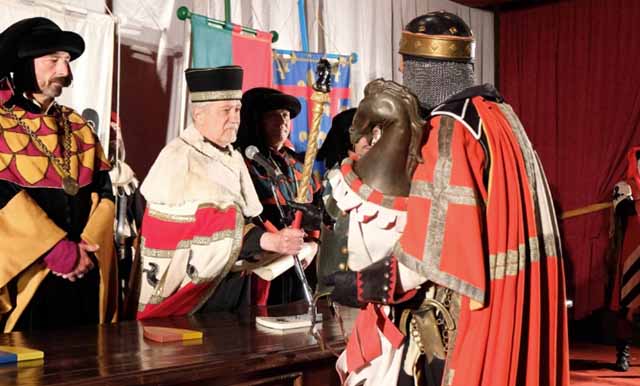
L’estrazione delle Carriere per la Giostra
The Sorting of Teams: Deciding the order of teams
Il sorteggio che si svolge in Piazza della Libertà determina l’ordine in cui i quattro quartieri si sfideranno nella Giostra. Le quattro rappresentanze armate di Porta Crucifera, Porta del Foro, Porta Sant’Andrea e Porta Santo Spirito si radunano per raggiungere il palco di fronte a Palazzo dei Priori. A presiedere il sorteggio ci sono il sindaco, in costume medievale, e i rettori.
The drawing that takes place in Piazza della Libertà determines the order in which the four neighborhoods will compete in the Giostra. The four armed representations of Porta Crucifera, Porta del Foro, Porta Sant’Andrea, and Porta Santo Spirito gather to reach the stage in front of Palazzo dei Priori. The drawing is presided over by the mayor, in medieval costume, and the rectors.
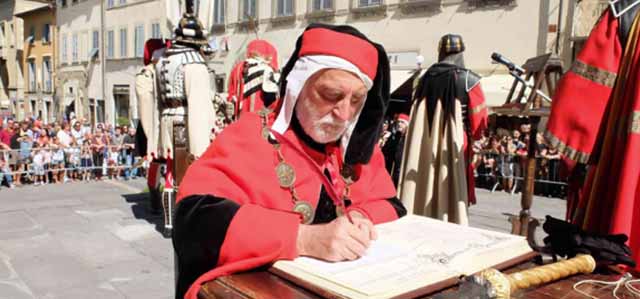
La Bollatura dei Cavalli
The Branding of the Horses
I cavalli e i loro cavalieri sono registrati e autenticati la mattina della giostra. I dettagli sono inseriti nel “Libro della Giostra.”
The horses and their riders are registered and authenticated on the morning of the joust. The details are entered in the “Book of the Joust.”
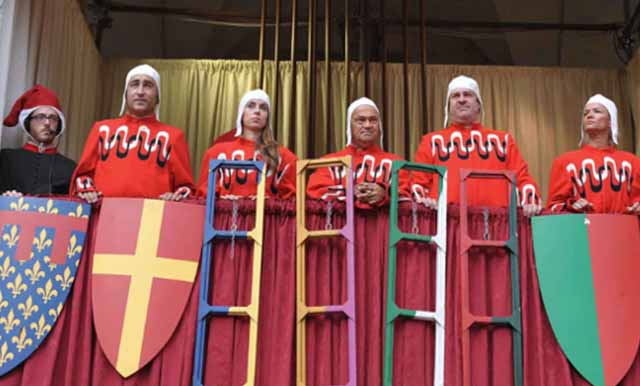
La giuria / The Jury
Il sorteggio che si svolge in Piazza della Libertà determina l’ordine in cui i quattro quartieri si sfideranno nella Giostra. Le quattro rappresentanze armate di Porta Crucifera, Porta del Foro, Porta Sant’Andrea e Porta Santo Spirito si radunano per raggiungere il palco di fronte a Palazzo dei Priori. A presiedere il sorteggio ci sono il sindaco, in costume medievale, e i rettori.
The drawing that takes place in Piazza della Libertà determines the order in which the four neighborhoods will compete in the Giostra. The four armed representations of Porta Crucifera, Porta del Foro, Porta Sant’Andrea, and Porta Santo Spirito gather to reach the stage in front of Palazzo dei Priori. The drawing is presided over by the mayor, in medieval costume, and the rectors.
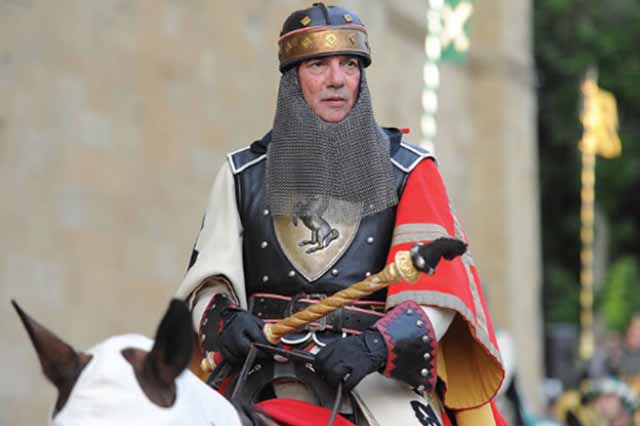
Capitano del Campo / The Field Steward
Ha la massima autorità sul campo ed è l’unico giudice di tutte le questioni tecniche inerenti all’esecuzione della Giostra del Saracino. Le sue decisioni sono irrevocabili.
He has the highest authority on the field and is the sole judge of all technical matters related to the execution of the Giostra del Saracino. His decisions are final.
Come si gioca La Giostra del Saracino
How the Game is Played
Primo Turno / Round 1.
Il primo giostratore entra in Piazza Grande dalla sommità e scende lungo la Lizza fino in fondo alla pista. Lì si posiziona, calma il cavallo e riceve una lancia di legno consegnata dalla giuria. La lancia ha una punta e un perno anneriti alla fine per lasciare un segno di puntura sulla scheda segnapunti. La lancia gli viene consegnata dal maestro di campo e, una volta che il giostratore è in piazza, solo lui e il maestro di campo possono toccarla. Il giostratore tiene la lancia nella mano destra e, a cavallo, corre sulla Lizza e colpisce il bersaglio tenuto dal Buratto. Il bersaglio tenuto dal Buratto è diviso in 10 settori con punteggi variabili da 1 a 5. Il centro, segnato da un cerchio rosso, rappresenta il punteggio massimo realizzabile.
The first jouster enters Piazza Grande from the top and descends along the Lizza to the end of the track. There he positions himself, calms the horse, and receives a wooden lance handed to him by the jury. The lance has a blackened tip and pin at the end to leave a puncture mark on the scoreboard. The lance is handed to him by the field master, and once the jouster is in the piazza, only he and the field master can touch it. The jouster holds the lance in his right hand and, on horseback, runs along the Lizza and hits the target held by the Buratto. The target held by the Buratto is divided into 10 sectors with points ranging from 1 to 5. The center, marked by a red circle, represents the highest score achievable.
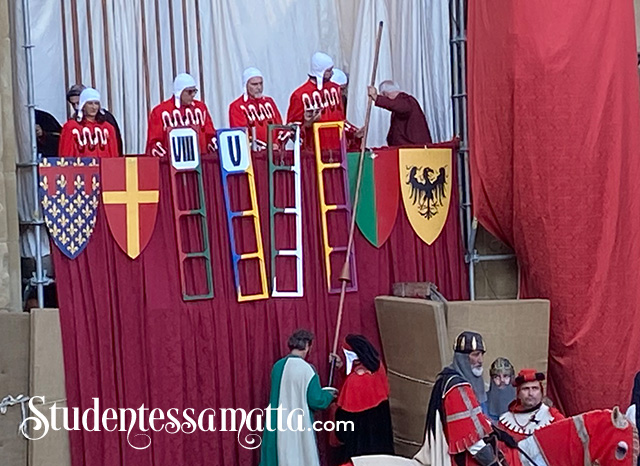
Una volta che il giostratore colpisce il bersaglio, i custodi del Buratto rimuovono rapidamente la scheda segnapunti e la consegnano ai giudici, che la esaminano attentamente per determinare il punteggio finale.
Once the jouster hits the target, the Buratto’s attendants quickly remove the scoreboard and hand it to the judges, who carefully examine it to determine the final score.
La decisione viene arrotolata e consegnata a un corriere, che la porta all’araldo al centro della piazza. L’araldo annuncia il punteggio al pubblico. Successivamente, un numero romano (I, II, III, IV, V) viene posizionato su una scala del punteggio davanti alla cabina del giudice.
The decision is rolled up and handed to a courier, who takes it to the herald in the center of the piazza. The herald announces the score to the public. Subsequently, a Roman numeral (I, II, III, IV, V) is placed on a scoring scale in front of the judges’ booth.
Il giostratore del quartiere successivo prende il suo turno, seguito dagli altri, fino a quando tutti e quattro hanno completato le loro corse sulla pista.
The jouster from the next neighborhood takes his turn, followed by the others, until all four have completed their runs on the track.
Primo Turno / Round 2.
I secondi giostratori di ogni squadra fanno le loro corse. A seconda del punteggio, tuttavia, se una squadra è in testa e un’altra squadra non può raggiungere il punteggio leader dopo il secondo turno, la Giostra potrebbe concludersi. Tuttavia, se i punteggi sono pari, la Giostra continua al terzo turno. I giostratori continuano a sfidarsi fino a quando non emerge un chiaro leader.
The second jousters from each team take their runs. Depending on the score, however, if one team is ahead and another team cannot reach the leading score after the second round, the Giostra might end. However, if the scores are tied, the Giostra continues to the third round. The jousters continue to compete until a clear leader emerges.
Penalizzazione e come guadagnare punti
Penalization and How to Gain Points
Leaving the Lizza = points are annulled
Interruption of the run = points annulled
Slow run = loss of 2 points
Jousters are unseated (fall of the horse) = loss of all points
Hit by the cat o’ nine tails = loss of 2 points
Refusal or forgetting to appear before the jury to present Lance = loss of all points
Appearing dismounted before the jury = loss of 2 points
Loss of lance = points annulled
Saracen fails to rotate = loss of points or repetition of runLoss of Points
Guadagnare punti / Gain points
Jouster grabs the cat o’ nine tails = plus 1, 2, 3 points
Breaking the lance = the score is doubled
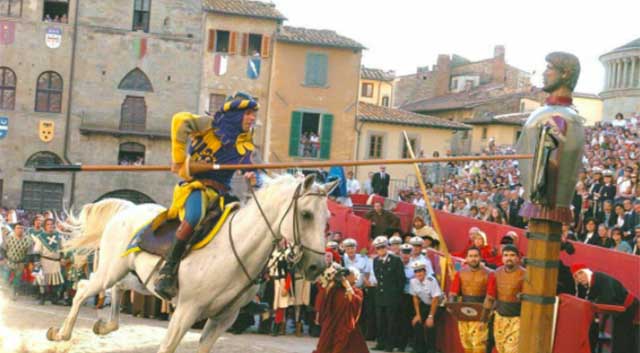
Giorno della Giostra Eventi in ordine di Avvenimento
Day of the Joust — Events in Order of Occurrence
7:00 am — Canon salute announcing the beginning of the jousting festivities.
10:30 am — Departure of the Municipal Foot Soldier and Valets from the Duomo
11:00 am — Second Canon salute: The Proclamation of the Joust announced by the Town Herald at the Town Commune near the Duomo. The Joust procession begins as the Civic Tower Bells toll. 350 costumed musicians & drummers, flag bearers, participants, and horses move through the town to each Quartiere.
12:30 pm — The Lancia d’Oro is in custody in the headquarters of Siena Arreti in Via Bicchieraia
2:00 pm — Third Canon salute: The Blessing of the Jousters in their Quartieri
2:30 pm — Parade Assembly in Piazza San Domenico
3:00 pm — Fourth Canon salute: Parade leaves Piazza San Domenico and moves to Duomo
3:15 pm — Blessing of the Quartieri and participants
3:30 pm — Final parade winds through the town’s historic district and enters Piazza Grande.
5:00 pm — Fifth Canon salute: Joust Opening Ceremony in Piazza Grande
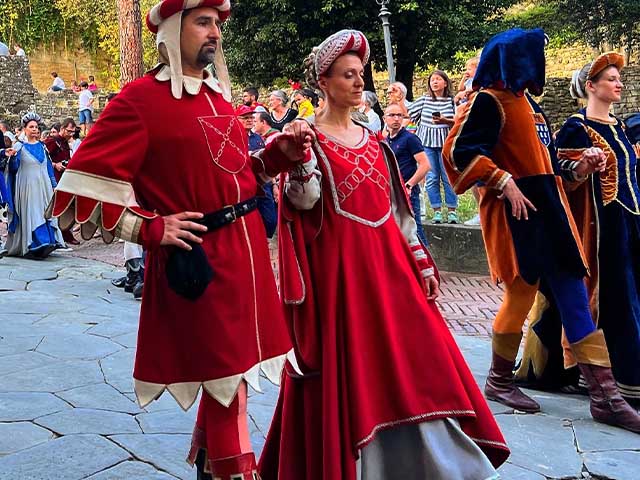
Il torneo dei cavalieri, o Giostra del Saracino, si svolge in Piazza Grande, guidato dal Maestro di Campo e preceduto dai personaggi in costume e dagli antichi stendardi della città che entrano nella piazza accompagnati da trombe e tamburi. I musicisti entrano in Piazza Grande con il corteo. I musicisti sono composti da 43 elementi, tra cui un alfiere, 11 tamburi, 27 chiarine e un capogruppo.
The knights’ tournament, or Giostra del Saracino, is held in Piazza Grande, guided by the Maestro di Campo and preceded by the costume characters and the town’s ancient banners entering the square accompanied by trumpets and drums. The musicians enter Piazza Grande with the corteo. The musicians consist of 43 elements, among which are a standard bearer, 11 drums, 27 clarions, and a group leader.
I membri della giuria, vestiti con toghe rosse e cappelli bianchi, entrano in piazza e si radunano nel palco della giuria. La giuria, composta da 5 membri imparziali, è incaricata di esaminare, deliberare e determinare infine il punteggio di ogni giostratore.
The jury members, dressed in red gowns and white caps, enter the piazza and assemble in the jury box. The jury, composed of five impartial members, is responsible for examining, deliberating, and ultimately determining each jouster’s score.
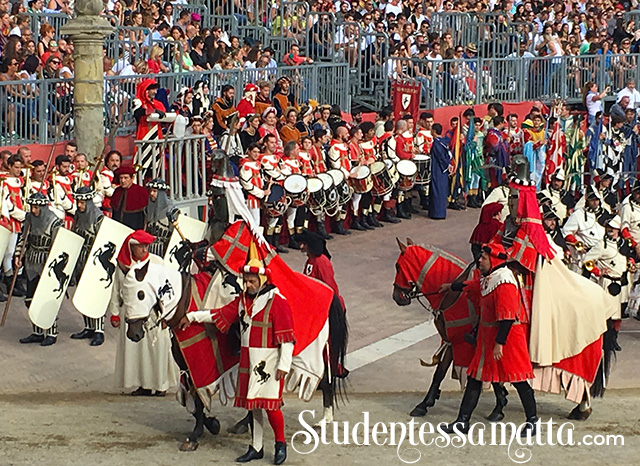
Gli sbandieratori si esibiscono davanti alla folla in Piazza Grande. L’Associazione Sbandieratori partecipa alla Giostra del Saracino dal 1931. Ogni anno, gli sbandieratori aprono l’evento con una tradizionale “scaramuccia” per simboleggiare l’antica contesa tra il bene e il male.
The flag wavers perform in front of the crowd in Piazza Grande. The Flag Wavers Association has been participating in the Saracen Joust since 1931. Every year, the flag wavers open the event with a traditional “skirmish” to symbolize the ancient contest between good and evil.
Successivamente vengono presentati i gonfaloni, e i rappresentanti delle più antiche famiglie nobili di Arezzo si allineano per essere riconosciuti dalla folla.
Next, the heraldic banners are presented, and the representatives of Arezzo’s oldest noble families line up to be acknowledged by the crowd.
L’araldo poi legge la Sfida del Buratto, seguita dal canto dell’inno del Saracino composto da Giuseppe Pietri.
The herald then reads the Challenge of the Buratto, followed by the singing of the Saracen hymn composed by Giuseppe Pietri.
Vengono presentati i giostratori e la sfida inizia.
The jousters are presented, and the challenge begins.
La giostra termina e viene dichiarato un vincitore.
The joust ends, and a winner is declared.
Il quartiere vincitore riceve la Lancia d’Oro nel Duomo.
The winning neighborhood is awarded the Golden Lance in the Duomo.
